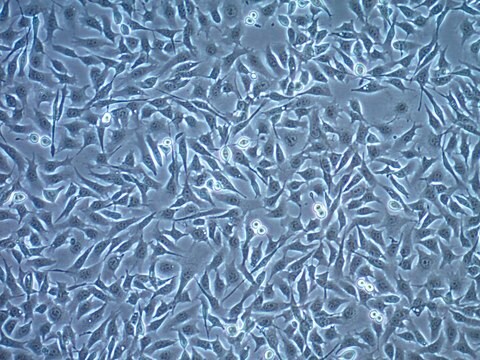SCC428
D4M-3A Mouse Melanoma Cell Line
Autenticatiper visualizzare i prezzi riservati alla tua organizzazione & contrattuali
About This Item
Codice UNSPSC:
41106514
NACRES:
NA.81
Prodotti consigliati
Origine biologica
mouse
Livello qualitativo
Confezionamento
vial of >1X10⁶ cells
Produttore/marchio commerciale
Millipore
Modalità di accrescimento
N/A
tecniche
cell culture | mammalian: suitable
Condizioni di spedizione
liquid nitrogen
Temperatura di conservazione
−196°C
Applicazioni
- Each vial contains > 1X106 viable cells.
- Cells are tested negative for infectious diseases by a Mouse Essential CLEAR Panel by Charles River Animal Diagnostic Services.
- Cells are verified to be of mouse origin and negative for inter-species contamination from rat, human, chinese hamster, Golden Syrian hamster, and Non-human Primate (NHP) as assessed by a Contamination Clear panel by Charles River Animal Diagnostic Services
- Cells are negative for mycoplasma contamination.
Melanoma is one of the most prevalent human cancers, affecting 1 out of every 50 individuals in their lifetime.1 The BRafV600E mutation, which occurs in nearly 50% in human melanomas, constitutively activates pERK, a component of the MAP kinase signaling pathway, and contributes to disease progression.2 Although human melanoma cell lines harboring the BRafV600E mutation are well-established, the reliance on xenografts in immunocompromised mice limits studies of host-tumor cell interactions in a syngeneic background.2
The D4M-3A cell line is a melanoma cell line from the conditional mouse model of metastatic melanoma: Tyr::CreER, BrafCA;Ptenlox/lox, which recapitulates human disease. Cultured D4M-3A cells express high constitutive pERK and respond to the BRafV600E inhibitor, Vemurafenib (PLX4032).2 D4M-3A cells lack melanin expression but maintain ability to express melanocyte differentiation antigens, which are important immune recognition factors. D4M-3A cells are transplantable in either immune-compromised or syngeneic B6 mice and show correlation of in vitro studies on molecular mechanisms of melanoma with in vivo investigations on pathology and immunology. The D4M-3A cell line is a clinically relevant model for both in vitro and in vivo studies of metastatic melanoma.
Source
The D4M-3A cell line was derived from a male transgenic Braf/Pten mouse.2
References
1. CA Cancer J Clin 2004, 54(3): 131-149.
2. Pigma Cell Melanoma Res 2014, 27(3): 495-501
The D4M-3A cell line is a melanoma cell line from the conditional mouse model of metastatic melanoma: Tyr::CreER, BrafCA;Ptenlox/lox, which recapitulates human disease. Cultured D4M-3A cells express high constitutive pERK and respond to the BRafV600E inhibitor, Vemurafenib (PLX4032).2 D4M-3A cells lack melanin expression but maintain ability to express melanocyte differentiation antigens, which are important immune recognition factors. D4M-3A cells are transplantable in either immune-compromised or syngeneic B6 mice and show correlation of in vitro studies on molecular mechanisms of melanoma with in vivo investigations on pathology and immunology. The D4M-3A cell line is a clinically relevant model for both in vitro and in vivo studies of metastatic melanoma.
Source
The D4M-3A cell line was derived from a male transgenic Braf/Pten mouse.2
References
1. CA Cancer J Clin 2004, 54(3): 131-149.
2. Pigma Cell Melanoma Res 2014, 27(3): 495-501
Caratteristiche e vantaggi
The D4M-3A cell line is a clinically relevant model for both in vitro and in vivo studies of metastatic melanoma
Stoccaggio e stabilità
The cells should be stored in liquid nitrogen until use. The cells can be cultured for at least 10 passages after initial thawing without significantly affecting functionality.
Altre note
This product is intended for sale and sold solely to academic institutions for internal academic research use per the terms of the “Academic Use Agreement” as detailed in the product documentation.
Esclusione di responsabilità
Unless otherwise stated in our catalog or other company documentation accompanying the product(s), our products are intended for research use only and are not to be used for any other purpose, which includes but is not limited to, unauthorized commercial uses, in vitro diagnostic uses, ex vivo or in vivo therapeutic uses or any type of consumption or application to humans or animals.;<bold>This product contains genetically modified organisms (GMO). </bold>Within the EU GMOs are regulated by Directives 2001/18/EC and 2009/41/EC of the European Parliament and of the Council and their national implementation in the member States respectively. This legislation obliges to request certain information about you and the establishment where the GMOs are being handled. <IS7_ContentPageCategoryLink target="Up.b.qB.CN8AAAFAnd8QWRbW">Click here for Enduser Declaration (EUD) Form</IS7_ContentPageCategoryLink>.
Codice della classe di stoccaggio
10 - Combustible liquids
Classe di pericolosità dell'acqua (WGK)
WGK 2
Punto d’infiammabilità (°F)
Not applicable
Punto d’infiammabilità (°C)
Not applicable
Certificati d'analisi (COA)
Cerca il Certificati d'analisi (COA) digitando il numero di lotto/batch corrispondente. I numeri di lotto o di batch sono stampati sull'etichetta dei prodotti dopo la parola ‘Lotto’ o ‘Batch’.
Possiedi già questo prodotto?
I documenti relativi ai prodotti acquistati recentemente sono disponibili nell’Archivio dei documenti.
Il team dei nostri ricercatori vanta grande esperienza in tutte le aree della ricerca quali Life Science, scienza dei materiali, sintesi chimica, cromatografia, discipline analitiche, ecc..
Contatta l'Assistenza Tecnica.







